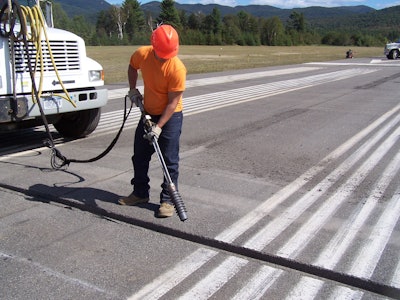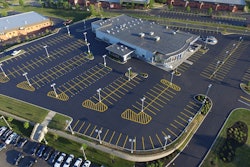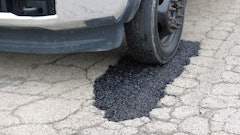
Generally, preservation treatments and pavement overlays are used to restore surface course characteristics such as smoothness, friction and aesthetics, or to add structural support to an existing pavement.
However, any preservation treatment needs to be placed on a structurally sound base. If an existing pavement is cracked or provides inadequate structural support, these defects will often reflect through even the best-constructed overlay and cause premature pavement failure in the form of cracks and deformations. To maximize the useful life of a pavement, failed sections of the existing pavements should be patched or replaced and existing pavement cracks should be filled.
Cracks are going to happen in asphalt pavement, and when they do it's your job to stop them from deteriorating the surface and creating potholes. Before proceeding with any type of surface treatment, consider these points about crack sealing as a preservation pretreatment.
What is it: Crack sealing is the placement of specialized treatment materials (crack sealant) above or into cracks to prevent the intrusion of water and incompressible materials.
Why crack sealing is needed: Cracking is a common and unavoidable type of damage found in asphalt pavement. The Asphalt Institute indicates that crack sealing is the single most important pavement maintenance activity. Sealing cracks promptly helps to prevent water penetration which can accelerate the deterioration of the pavement and result in potholes and base failures.
Where to do it: Crack sealing maintains a tightly sealed crack only as long as the pavement remains stationary and the pavement is structurally sound. In climates with extreme temperatures, where expansion and contraction of the pavement occurs often, resealing may be necessary every year. Sealing and filling should be done only on dry surfaces and when the temperature is above 40 F°. (Cooler temperatures cause the pavement to contract, opening the crack and making it easier to fill properly.) Traffic can be allowed on sealed cracks immediately if a detackifying agent is used, otherwise traffic should not be allowed on the sealed cracks until sealant has cured.
Why/when you should not crack seal: According to the Asphalt Institute, sealing and filling cracks should not be done on a pavement that has significant structural problems as crack sealing or filling does not provide any structural improvement to the pavement. If the pavement has base failures, severe rutting or fatigue (alligator) cracking, crack sealing/filling is not an appropriate preservation option.
Preservation prognosis: Crack sealing can extend the life of the pavement 2-5 years; can provide a 10 point sustained increase in Pavement Condition Index for 7 years vs. an untreated crack; can reduce potholes and secondary cracking; and can maintain pavement smoothness over a 5-year period vs. a pavement without crack sealing.





![[VIDEO] Electric LineLazer ES 1000 quietly delivers results](https://img.forconstructionpros.com/files/base/acbm/fcp/image/2017/02/default.58adc6ac3f91b.png?auto=format%2Ccompress&fit=crop&h=167&q=70&w=250)
![[VIDEO] Bomag’s RS500 Side-Shifting Reclaimer/Stabilizer is Powerful, Flexible and Safe](https://img.forconstructionpros.com/files/base/acbm/fcp/image/2017/03/default.58be626aa9bba.png?auto=format%2Ccompress&fit=crop&h=167&q=70&w=250)
![[VIDEO] 312 Cold Planer designed for large and small milling operations](https://img.forconstructionpros.com/files/base/acbm/fcp/image/2017/03/default.58be24f1b9552.png?auto=format%2Ccompress&fit=crop&h=167&q=70&w=250)













